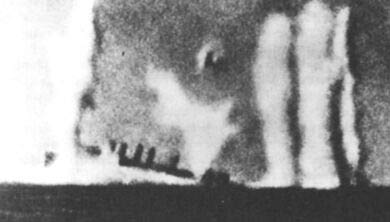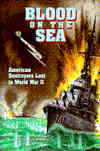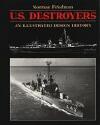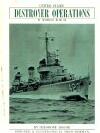Allied Warships
USS Pope (i) (DD 225)
Destroyer of the Clemson class

USS Pope being sunk by the Japanese
| Navy | The US Navy |
| Type | Destroyer |
| Class | Clemson |
| Pennant | DD 225 |
| Built by | William Cramp and Sons (Philadelphia, Pennsylvania, U.S.A.) |
| Ordered | |
| Laid down | 9 Sep 1919 |
| Launched | 23 Mar 1920 |
| Commissioned | 27 Oct 1920 |
| Lost | 1 Mar 1942 |
| Loss position | 4° 00'S, 111° 30'E |
| History | USS Pope (Lt.Cdr. Welford Charles Blinn, USN) departs Surabaya, Netherlands East Indies on 28 February 1942 together with the British heavy cruiser HMS Exeter and the British destroyer HMS Encounter. The ships are ordered to try to escape through the Sunda Strait to Tjilatjap. Unfortunately they are spotted by Japanese warships and the Exeter and Encounter are sunk during the following engagement. Pope manages to escape only to be bombed by Japanese aircraft which leaves her unmanouverable after a near-miss. She is finally sunk by gunfire from Japanese warships in position 04º00'S, 111º30'E on 1 March 1942.only one rating is killed and 8 wounded which include the Commanding officer however 152 of the crew are Rescued by the IJNS Inazuma and Kawakaze and made Prisoners of war. Only 123 are liberated which include the Commanding officer and 29 died in captivity. For the full action report see this website (offsite link). |
Commands listed for USS Pope (i) (DD 225)
Please note that we're still working on this section
and that we only list Commanding Officers for the duration of the Second World War.
| Commander | From | To | |
| 1 | Lt.Cdr. Clarence Lee Connor Atkeson, USN | 5 Aug 1939 | 20 Jul 1940 |
| 2 | Lt.Cdr. Henry Theodore Wray, USN | 20 Jul 1940 | 23 Jan 1941 |
| 3 | Lt. Richard Nott Antrim, USN | 23 Jan 1941 | 10 Feb 1941 |
| 4 | Lt. Welford Charles Blinn, USN | 10 Feb 1941 | 1 Mar 1942 |
You can help improve our commands section
Click here to Submit events/comments/updates for this vessel.
Please use this if you spot mistakes or want to improve this ships page.
Notable events involving Pope (i) include:
19 Feb 1942
Battle of Badoeng Strait
It was expected that the Japanese would soon land (night of 19/20 February 1942) on the south-east coast of Bali (Badoeng Strait). Rear-Admiral Doorman therefore wanted to attack them in three waves. The first wave came from Tjilatjap on the south coast of Java and consisted of the Dutch light cruisers HrMs De Ruyter (Cdr. E.E.B. Lacomblé, RNN and flagship of Rear-Admiral K.W.F.M. Doorman, RNN) and HrMs Java (Capt. P.B.M van Straelen, RNN), escorted by the Dutch destroyers HrMs Piet Hein (Lt.Cdr. J.M.L.I. Chompff, RNN) and HrMs Kortenaer (Lt.Cdr. A. Kroese, RNN) as well as the US destroyers USS John D. Ford (Lt.Cdr. J.E. Cooper, USN) and USS Pope (Lt.Cdr. W.C. Blinn, USN). However while leaving Tjilatjap in the evening of the 18th the Dutch destroyer Kortenaer grounded and was only able to get of at high tide therefore was no longer part of this force.
The second wave was made up of the Dutch light cruiser HrMs Tromp (Cdr. J.B. de Meester, RNN) and four US destroyers; USS Stewart (Lt.Cdr. H.P. Smith, USN), USS Parrott (Lt.Cdr. J.N. Hughes, USN), USS Pillsbury (Lt.Cdr. H.C. Pound, USN) and USS John D. Edwards (Lt.Cdr. H.E. Eccles, USN). They sailed from Surabaya in the afternoon of the 19th
Finally the third wave was made up of the Dutch Motor Torpedo Boats; HrMs TM-4 (Lt. J.E. Gobée, RNN), HrMs TM-5 (S.Lt. E.J. Hoeksel, RNN), HrMs TM-6 (S.Lt. P. van Rees, RNN), HrMs TM-8 (Lt. J.G. Treffers, RNN), HrMs TM-9 (Lt. J.A. van Beusekom, RNN), HrMs TM-10 (S.Lt. J.W. Boon, RNN(R)), HrMs TM-11 (S.Lt. A.A.F. Schmitz, RNN), HrMs TM-15 (Lt. H.C. Jorissen, RNN). HrMs TM-13 (?) was also part of this force but acted as 'rescue boat'. Shortly after their sailing from Surabaya in the evening of the 18th HrMs TM-6 was forced to return due to engine trouble. These Motor Torpedo Boats proceeded through Strait Bali and anchored in three bay's on the Java side to refuel which took the whole day. In the evening of the 19th they departed for Badoeng Strait.
The Japanese attack on Bali was carried out by two transport ships Sasako Maru (7180 GRT, built 1941) and Sagami Maru (7189 GRT, built 1940). They had on board part of the Imperial Japanese Army’s 48th Infantry Division and had departed Makassar for Bali during the night of 17/18 February. They were escorted by four destroyers; Asashio (Lt.Cdr. G. Yoshii), Oshio (Cdr. K. Kikkawa) Arashio (Cdr. H. Kuboki) and Michishio (Lt.Cdr. M. Ogura). Distant cover was provided by the light cruiser Nagara (Capt T. Naoi, flagship of Rear-Admiral K. Kubo) escorted by three destroyers Hatsushimo (Lt.Cdr. S. Kohama), Nenohi (Lt.Cdr. T. Chihagi) and Wakaba (Lt.Cdr. M. Kuroki).
The Japanese landed around 0200/19 on the south coast of Bali. The transports were attacked unsuccessfully by the American submarine USS Seawolf. Seawolf herself was then counter attacked with depth charges by the destroyers but managed to escape.
During the day the Japanese transports were attacked from the air and the Sagami Maru was damaged. She left the landing zone escorted by the destroyers Arashio and Michishio. The undamaged Sasako Maru remained in the landing zone to pick up the landing barges. The destroyers Asashio and Oshio remained with her.
The allied first attack wave arrived south of Bali around 2130/19. A line was then formed in the order, HrMs De Ruyter, HrMs Java, HrMs Piet Hein, USS John D. Ford and finally USS Pope. Speed was increaded to 27 knots and they proceeded up Badoeng Strait. Around 2230 hours HrMs De Ruyter and HrMs Java opened fire on the Japanese which were taken by surprise. The Asashio turned a searchlight on which was quickly taken out by a salvo from the Java. The Dutch cruisers claimed heavy damage on the enemy but according to Japanese reports on the battle damage was only minor and after being initially taken by surprise the Japanese soon counter attacked. By that time however the Dutch cruisers had moved on.
The Allied destroyers were further behind the cruisers then intended and now arrived on the scene. Piet Hein was a little ahead of the US destroyers and opened fire with her 4.7” guns and also fired two torpedoes. Shortly afterwards two more torpedoes were fired but none found their intended target. Piet Hein then turned around towards the US destroyers with the intention to attack the Japanese again. While doing so her smoke generator was started. It is not completely clear but it is possible that one of these US destroyers then engaged Piet Hein with gunfire thinking she was Japanese. It is also possible that it were the Japanese that engaged Piet Hein. At this time Piet Hein was hit several times, resulting in her to come to a stop. After about 15 minutes Piet Hein was illuminated by a Japanese searchlight and taken under fire. The crew was ordered to abandon the doomed destroyer and she soon sank.
USS John D. Ford and Pope sighted a Japanese transport vessel (this must have been the Sasaga Maru) and what they thought to be a Japanese cruiser but this must have been the destroyer Oshio. They launched torpedoes (Ford – three, Pope - five) and turned away. Asashio and Oshio when went after them. The Americans thought they faced a very powerful enemy, even heavy cruisers were thought to be present. Both destroyers then retired to the south-east to return to Tjilatjap. Shortly afterwards they heard gunfire. This gunfire was coming from both Japanese destroyer that were now engaging each other by mistake. After a few minutes the mistake was noticed and both Japanese destroyer retired up the Strait to the north.
Meanwhile the Allied second attack wave was nearing the scene of the action. They had arrived south of Bali around 0100/20. The four US destroyers were ahead of the Tromp. It was intended that the four US destroyer would enter Badoeng Strait and attack with torpedoes first and that the Tromp would come behind them to finish off the Japanese after the confusion of the torpedo attack. During the torpedo attack a total of fifteen torpedoes were fired, six each by USS Stewart and USS Pope and three by USS Pillsbury. Their targets, Asashio and Oshio were not hit and both Japanese destroyers now went after their attackers. Stewart was then hit with gunfire. The US destroyers then set course to the east to leave Badoeng Strait. Now Tromp went in. Soon she was illuminated by a searchlight and the Japanese opened fire. Thy obtained eleven hits on the Tromp causing heavy damage to the Dutch cruiser. The Oshio on her turn was seriously damaged by the Tromp. The action was over around 0215/20 and Tromp retired from the Strait to the north-east. When north of Bali she went to full speed and returned to Surabaya for repairs.
Japanese Rear-Admiral Kubo, on board the Nagara, had meanwhile ordered the Arashio and Michishio to return to Badoeng Strait (Nagara and her three escorting destroyers were too far off). When the two Japanese destroyers entered the Strait they encountered the four US destroyers. Both sides launched torpedoes but all missed their intended targets and then a gunfight was started. During this gunfight the Michishio was heavily damaged and in the end she had to be towed back to Makassar. The US destroyer meanwhile continued to retire from the area.
The third wave then entered the Strait. The Dutch MTB’s had seen the second wave attacking but when they entered Badoeng Strait the Japanese were not sighted and they left without being able to fire torpedoes.
The Allies were at that time under the impression that they had obtained a victory. They thought to have sunk a Japanese cruiser and have damaged two more cruisers and two destroyers. This was not the case, one Japanese destroyer was heavily damaged and one seriously. In return the Japanese sank a Dutch destroyer and damaged the Dutch cruiser Tromp heavily. As the Dutch naval base at Surabaya was now under daily air attack it was deemed wise to sent the Tromp to Australia for repairs.
28 Feb 1942
The sinking of HMS Exeter, HMS Encounter and USS Pope.
Sailing of these ships from Surabaya and course to follow.
Following the lost battle of the Java Sea Surabaya was evacuated. The damaged British heavy cruiser HMS Exeter (Capt. O.L. Gordon, MVO, RN), the British destroyer HMS Encounter (Lt.Cdr. E.V.St J. Morgan, RN) and the US destroyer USS Pope (Lt.Cdr. W.C. Blinn, USN) departed Surabaya at 1900/28 with orders to proceed to the east for 20 nautical miles, then to proceed northwards to pass to the east of Bawean Island and then to proceed to the north-west an finally to the west to try to escape to Colombo via the Sunda Strait.
The mission actually hopeless, HMS Exeter, in her damaged condition could make no more then 16 knots when she sailed from Surabaya. Repairs however were under way and while at sea speed could eventually be increased to 23 knots. The other two ships were also in need of repairs and were not 100% fit for battle. USS Pope had been unable to take part in the Battle of the Java Sea as she had been repairing at Surabaya. Besides the ships themselves their crews were also suffering from fatigue due the immense strain they had been under the past weeks. The Dutch destroyer HrMs Witte de With (Lt.Cdr. P. Schotel, RNN) was to have sailed with these ships ass well to try to escape but she remained behind with either damage to her propellers and / or an incomplete crew (shore leave had been granted, sources vary on this) and was eventually scuttled to prevent her capture by the Japanese.
The first part of the night of 28 February / 1 MArch was uneventful. The two destroyers had taken up screening positions and shortly before midnight steam was available to two more boilers in HMS Exeter and speed was increased in steps to 23 knots, which was the maximum speed that could be obtained with the four boilers now operational.
Japanese forces deployed to intercept the Allied ships trying to escape.
Unknown to the Allies at this time was that the ships had already been spotted by Japanese aircraft shortly after they had left the harbour and the Japanese deployed their forces in the eastern part of the Java Sea to intercept them.
These forces were split into two groups. One group was made up of the heavy cruisers Nachi and Haguro with the destroyers Kawakaze and Yamakaze. The other group was made up of the heavy cruisers Ashigara and Myoko and the destroyers Akebono and Inazuma.
Movements of the Allied ships during the night.
Shortly before midnight the Allied ships changed course to due north to pass to the east of Bawean Island as ordered. Speed was now 23 knots, the maximum speed of HMS Exeter. At 0200 hours, course was altered to 345 degrees.
It had been intended to alter course to 290 degrees at 0400/1 but shortly before this three ships, two large and one smaller were sighted to the westward in the light of the setting moon. Range to these ships was about 10 nautical miles. They were steering to the south-south-west and were thought to be two transports escorted by a cruiser or a destroyer. They were evaded as the ships had orders to try to escape to Colombo. The Allied ships therefore turned stern on to avoid being sighted. They then worked round to the northward and resumed their course of 345 degrees at about 0430 hours.
Around 0600 hours course was altered to 290 degrees and one hour later to 280 degrees. No enemy aircraft nor ships were seen at daybreak and visibility was extreme.
Enemy ships sighted.
At about 0750 hours the lookout in the crow's nest on board HMS Exeter reported sighting two ships nearly right ahead. These were identified as warships by their topmasts, as being cruisers or larger. The enemy ships were steering to the north-north-east. Course was immediately altered to try to evade and it was though possible that with the advantage of the light HMS Exeter had not been sighted. This hope was however short lived as the enemy ships were soon seen to turn towards though they were still well hull down.
An enemy report was therefore made. However the ememy soon resumed their original course and were out of sight shortly afterwards. Their turn towards was perhaps only for flying off operations to launch their aircraft to conduct a search.
The Allied ships worked gradually to the southward and westward eventually steering 260 degrees.
More enemy warships sighted.
It was not until about 0935 hours that the topmasts of two enemy heavy cruisers were sighted bearing about 170 degrees, steering to the westward. Course was immediately altered to 320 degrees to try to evade but these cruisers were also seen to turn towards. Very shortly afterwards an enemy destroyer was seen ahead steering towards. This destroyer was then engaged with gunfire at ranges between 20000 and 14000 yards. The destroyer eventually turned away to the westward under the cover of smoke.
Shortly afterwards two more Japanese heavy cruisers were sighted bearing approximately 330 degrees. These also turned towards at once. The Allied ships immediately altered course to the east.
On board the Exeter the ships engine room staff meanwhile had managed to repair another boiler and speed was increased around 1055 hours to 26 knots.
Enemy ships open fire.
The enemy cruisers to the north-west were the first to open fire from long range. Their fire was immediately returned by HMS Exeter. Also another enemy report was made.
Due to a malfunction in the fire control table all salvoes fired by HMS Exeter missed the enemy ships.
One pair of the enemy cruisers were approximately abeam to starboard and the other pair were on the port quarter. They closed gradually until the range was about 18000 yards.
About the time the enemy cruisers found the range, USS Pope made smoke without having received the order to do so. HMS Encounter followed suit and the resulting smoke screen proved effective. Targets were engaged by HMS Exeter whenever these were sighted through the smoke but it was seldom to fire more then four or five salvoes at a time.
At about 1100 hours, HMS Exeter fire her port tubes at he enemy cruisers on her port quarter. The enemy took avoiding action and no hits were obtained. HMS Encounter could not make a torpedo attack, she had none on board having fired all her torpedoes during the Battle of the Java Sea.
Around this time all the Allied ships also engaged Japanese destroyers with gunfire. HMS Exeter claims to have damaged one of them.
During the action the enemy had spotter aircraft overhead the Allied ships. These were engaged with AA fire whenever possible.
HMS Exeter hit and sunk.
Around 1120 hours, HMS Exeter received a vital hit in 'A' boiler room which started a large fire and the boiler room had to be evacuated. Steam pressure dropped rapidly and in the end the main engines had to be stopped. All power failed in the ship shortly afterwards, and with it the whole main armament and also the secondary armamant control.
As HMS Exeter was loosing way, HMS Encounter and USS Pope drew ahead. The enemy fire now became very effective on the almost stationary Exeter which was repeatidly straddled and hit.
Abandon ship was ordered at 1135 hours. This order was carried out in an orderly manner. HMS Exeter sank around 1150 hours.
Sinking of HMS Encounter.
Soon after HMS Exeter was brought to a halt, HMS Encounter also had to stop due to damage received in the engine rooms by splinters. HMS Encounter then tried to hide in her own smoke screen but the enemy ships soon found the range and soon all her guns, except 'B' gun, were out of action due to hits received.
Being stopped, with almost all her main armament out of action and without torpedoes, abandon ship was then ordered and HMS Encounter sank at 1210 hours.
Action continued by the sole remaining Allied ship, USS Pope.
USS Pope temporary managed to escape from the Japanese warships hiding in rain squalls. Eventually she was found and disabled and brought to a halt by damage received from aircraft from the Japanese aircraft carrier Ryujo.She was finally sunk by gunfire around 1440 hours from the Ashigara and the Myoko. (1)
Media links
|
|
|
|
Sources
- ADM 267/84
ADM numbers indicate documents at the British National Archives at Kew, London.
As an Amazon Associate uboat.net earns a commission from qualifying purchases.





